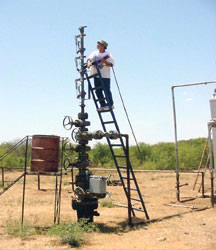Automatic soapstick launcher increases gas production
Automatic soapstick launcher increases gas productionKurt von Plonski, Battlecat Operating Co., Midland, Texas; Charlie Seidel, CWS Gauging Services, Cotulla, Texas; and James C. (Jim) Votaw and Jeanne Votaw, J&J Oilfield & Electrical Service, Perry, Oklahoma Bottom line. To keep Edwards Lime and Olmos gas wells in South Texas unloaded for a full 24 hours, Silver Pines Energy Corp. installed automatic soapstick launchers. The production gain from four wells is 272 Mcfgd, equating to $588/day incremental revenue at a representative $3.00/Mcf gas price. Launchers, which cost only about $5,000, typically pay out within weeks, and the additional soapsticks cost only about $6/day, per well. Problem addressed. Edwards Lime and Olmos gas wells operated by Silver Pines Energy Corp. in South Texas were loading up with water. Manually launched soapsticks would unload wells for a time, but they would not keep the well unloaded until the gauger made his rounds the next day. Knowing that soapsticks worked, Silver Pines wanted to stay with this low-cost approach. However, a reliable automatic launcher that would launch soapsticks unattended, until the gauger made his next scheduled round, was needed. Operational background. Silver Pines operates the Sun TSH and Stuart City fields in LaSalle County, Texas, in which Battlecat owns an interest. The leases have 32 wells producing either sour gas from the Edwards Lime at about 11,000 ft, or sweet gas from the Olmos sand at 7,500 ft. Both formations are tight, and as production matured, the wells began loading up with water. Area operators learned that soapsticks would keep wells unloaded, but in the Silver Pines wells, soapsticks launched by the gauger each day would not keep wells unloaded a full 24 hr. Production was being lost, and more frequent visits by the contract gauger were not an economical option. Another area operator for whom the contract gauger provided services had had good success using automated soapstick launchers provided by J&J Oilfield & Electrical Service (J&J). Silver Pines realized that other options, such as capillary tubing, plunger lift or artificial lift, existed. Nevertheless, the low-cost soapstick option was keeping wells unloaded – just not long enough. The low-cost, easily installed, automated launcher that other operators had successfully used was their first choice for a field solution. Automated soapstick launcher. The automated soapstick launcher, shown installed on a wellhead in the accompanying photo, is relatively simple. At its most basic, the launcher consists of metal chambers connected by ball valves. It can be configured to deliver up to 12 soapsticks at intervals set manually with a timer. Electronically controlled, pneumatic cylinders open and close the valves, according to timer settings. In its early production, the launcher used well gas or CO2 cartridges. However, to improve dependability and require less of the gauger’s time for changing bottles, the solar-charged pneumatic system has evolved. The use of electrical components, in lieu of complicated electronic devices, contributes to reliability. When needed, most repairs take less than an hour.
Installation takes only a few hours. The firm has a "try-before-you buy" policy, whereby the company installs the launcher and lets operators see whether it improves well performance before invoicing them. Often, launchers pay out before invoices are even sent. Should a well not experience the expected benefits, the launcher can be removed quickly and/or relocated to another candidate well. Based on more than 400 units in the field, the service provider claims an average increase of 60 Mcfgd. Economic results in Edwards Lime wells. The accompanying table summarizes production and economic results for Silver Pines’ four wells. Production rates are averages that represent well performance, before and after launcher installation. Before launcher installation, one soapstick was launched manually. After launcher installation, one soapstick was manually launched by the gauger during his daily rounds, and two additional soapsticks were automatically launched at 8-hr intervals. The additional soapsticks cost $6/day, per well. Combined incremental daily revenue, using an assumed representative gas price of $3.00/Mcf and adjusted for additional soapsticks, is $588. Per well increases range from $77 to $260/day. On this basis, average payout period for the $5,000 launchers was about five weeks.
Further possibilities. For these wells, launch intervals were set at 8 hr, based on observation of historical charts. Silver Pines is exploring a flowrate-based control system that would allow soapsticks to be launched when a well’s rate falls a given percentage or amount. With increased capability comes increased complexity and cost – for now, manual timer settings are providing significant economic benefit. PTD
|
||||||||||||||||||||||||||||||||||||||||||||||||||||||||||||||||||||||||||||||
- Shale technology: Bayesian variable pressure decline-curve analysis for shale gas wells (March 2024)
- What's new in production (February 2024)
- Prices and governmental policies combine to stymie Canadian upstream growth (February 2024)
- U.S. operators reduce activity as crude prices plunge (February 2024)
- U.S. producing gas wells increase despite low prices (February 2024)
- U.S. drilling: More of the same expected (February 2024)



